Teamwork Lessons From Horses
Animals can teach us many things, especially an animal as empathic as the horse. I was fortunate enough recently to take a vacation to Glacier National Park. If you have never been there, I highly recommend it. During this vacation, I was able to take a 7-hour horse ride through the mountains to a glacier lake and valley. During the ride, I noticed that the lead horse’s ears were facing forward and the other horse’s ears were facing sideways. I inquired about this and this is what I learned.
When riding in a line, in basically a nose-to-tail formation, whichever horse is in the lead will automatically look forward and face their ears to hear noises and potential problems ahead of the other horses. The other horses are looking for threats to the side and behind the pack. No horse wants to let the other horses down, so they all naturally do this. It is in the best interest of the team.
While doing this, the horses communicate using what is called a deictic gaze, according to Brain Games. Animals will look a potential object or threat to draw attention to that particular object without drawing attention to themselves. After all, in the wild, what they see may be after them. Each horse is attuned to the body language of the others and picks up on where the other horses are looking, making everyone aware of any threat. [The lead horse will notify the team of threats up ahead, and make sure not to head into them.] But for this to work, each team member must do their job. The mentality here is not one of the individual but of the group. Any missed threats in any direction could cost the whole pack or team, especially when in the backwoods of bear (and moose?) country, like we were.
This made me think about work teams. What if every team and every team member instinctively thought this way? If each person on the team naturally took responsibility and accountability for their place and role on the team? This isn’t natural in today’s work environment. Some of our team may be thinking of survival, but of individual survival vs. the team. And some may be new to working in an office and may not be aware of this at all. As leaders and managers, we need to remember that this is not instinctive and that there may be ulterior motives or personal agendas at work and work to overcome it. This can take the form of formal or informal training, mentoring, coaching and/or leading by example.
What have you done to get your team aligned with your organizational or project goals? To take responsibility for their part of the team? To work together as a team? Post a comment here or write me and I will compile the inputs in a future article. We can all be better managers by learning from others.
Note: The incredible thing about our ride was that the weather was sunny and beautiful on the way out and for our lunch stop. Gorgeous! At the end of our stop, the clouds starting rolling over the mountains and the weather got cold and foggy. The whole way back was in the fog and snow. Eerie! We in essence had two completely different rides, and it was wonderful!
For more information on the lessons horses can teach us, see Karen Smith’s article on intent vs. confidence.





